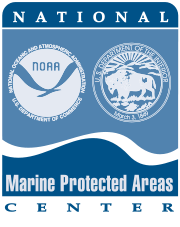- United States National System of Marine Protected Areas
-
The National System of Marine Protected Areas of the United States is a national initiative designed to strengthen the protection of U.S. ocean, coastal, and Great Lakes resources through the coordination of existing marine protected areas (MPAs). The national system of MPAs consists of the group of MPA sites, networks, and systems established and managed by federal, state, territorial, tribal and/or local governments that collectively enhance conservation of the nation’s marine heritage and represent its diverse ecosystems and resources. Although managed independently, national system MPAs work together at the regional and national levels to achieve common objectives for conserving the nation’s important natural and cultural resources. The national system dos not bring state, territorial or local sites under federal authority, nor does it restrict or change the management of any MPA.
Background
Over the past century, MPAs have been created by a mix of federal, state, and local legislation, voter initiatives, and regulations, each established for its own specific purpose. As a result, the nation’s collection of MPAs (e.g., reserves, refuges, preserves, sanctuaries, areas of special biological significance, and others) is fragmented, complex, confusing, and potentially missing opportunities for broader regional conservation through coordinated planning and management. In 2000, a broad coalition of scientists petitioned the White House to create a national system of MPAs to improve conservation of the nation’s marine ecosystems, cultural resources, and fisheries. Presidential Executive Order 13158 was signed on May 26, 2000, directing the Department of Commerce to work with the Department of the Interior, other federal agencies, states, territories, tribes and stakeholders to establish a national system of MPAs to integrate and enhance the nation’s MPAs, bringing these diverse sites and programs together to work on common conservation objectives.
MPAs protect ecosystems and resources such as coral reefs, kelp forests, shipwrecks, and those areas frequented by whales and other marine life. They also can provide protection to economically valuable coastal and marine resources including commercial and recreational fisheries. The national system includes MPAs throughout the marine environment of the U.S. and its territories, including coastal areas, estuaries, oceans and the Great Lakes. As a first step in developing the national system of MPAs, the MPA Center compiled an MPA Inventory of all MPAs in U.S. waters. The U.S. has over 1,600 MPAs, ranging from typically small fully protected marine reserves where extractive uses are prohibited to large, multiple-use areas where fishing, diving and other uses are permitted. Most MPAs in U.S. waters allow some type of extractive use, with less than 1% of U.S. waters fully protected marine reserves where extractive activities are not permitted.
The national system is described in detail in the Framework for a National System of Marine Protected Areas of the United States of America.
In April 2009 the National System of Marine Protected Areas was officially established with the acceptance of the first 225 charter sites. A second nomination process was held in Fall 2009, and additional sites will be admitted to the system in 2010 on an annual basis thereafter. The nomination process is transparent, science-based, and provides an opportunity for public comment.
The national system of MPAs provides the first comprehensive mechanism for coordinating MPAs managed by diverse federal, state, territorial, tribal and local agencies to work toward national conservation objectives. The system will benefit the nation’s collective conservation efforts and participating MPAs, providing those sites with a means to address issues beyond their boundaries. Examples of some of these benefits include:
- Enhanced stewardship through better coordination, public awareness and enhanced site management capacity
- Building partnerships for MPAs to work together toward common conservation objectives
- Increased support for marine conservation through the recognition provided by the national system
- Protecting representative ecosystems and resources from all the nation’s ecosystem and habitat types
- Identifying gaps in current protection of ocean resources to help inform future MPA planning
- Transparent process for MPA planning that is science-based and includes a commitment to balanced stakeholder involvement.
External links
- US Government website for Marine Protected Areas
- Executive Order 13158 -- Marine Protected Areas (.pdf), US Government Printing Office, May 26, 2000
- National System Fact Sheets
- MPA Virtual Library
- MPA Inventory
Categories:- Clinton Administration initiatives
- 2000 in law
Wikimedia Foundation. 2010.


